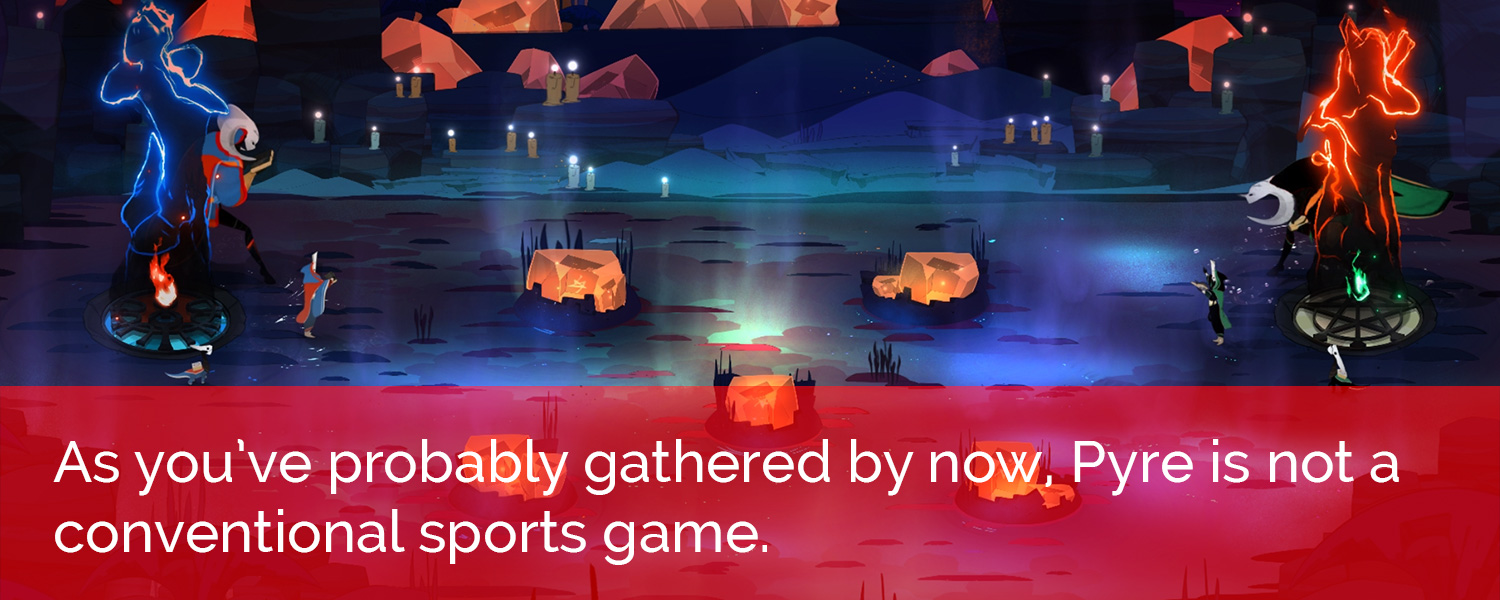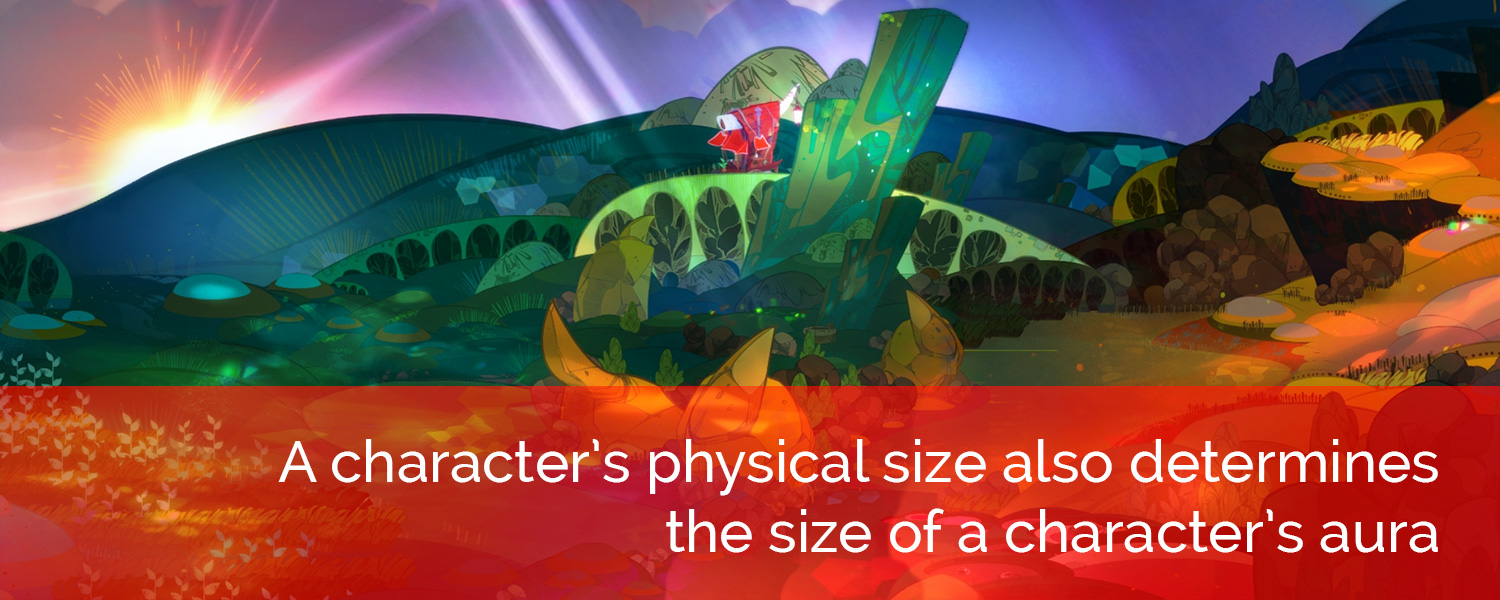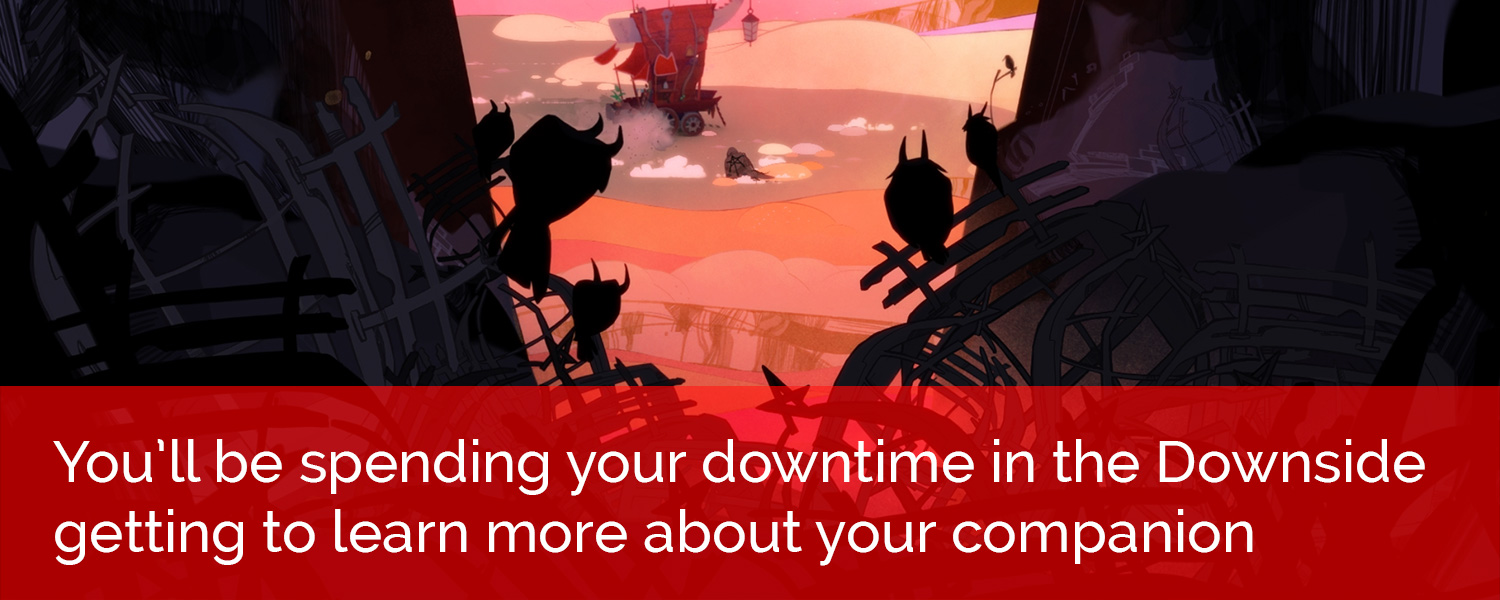Like Supergiant Games’ previous games Bastion and Transistor, Pyre has striking aesthetics, a poignant soundtrack, a world that arouses intrigue and a narrative that focuses on internal and external journeys. Except, there’s one major difference, it’s a sports game. However, the combatants in Pyre aren’t playing for a championship trophy, they’re playing for a chance to escape from an interminable purgatory imposed onto them by the country they once inhabited.
The country responsible for creating these exiles is called the Commonwealth, the purgatory they’re banished to is known as the Downside. Unfortunately for you, you’re occupying the latter. You play as the Reader, an exile on the verge of succumbing to the unrelenting conditions of the Downside until you’re rescued by a passing trio of exiles. The Downside contains people from all walks of life and your saviours are no exception – there’s a scrappy cur named Rukey, an austere man named Hedwyn and an imposing female demon by the name of Jodariel. Why they’re exiled is unimportant, what is important, is that they know a way to freedom. You’re informed by the trio that exiles are able to return to the Commonwealth if they atone for their sins by successfully competing in a ritual known as the Rites. Thankfully for you, they need your skills in order to participate – and are thus recruited by the band of bandits on their journey for salvation.
As you’ve probably gathered by now, Pyre is not a conventional sports game. If anything, it’s one half sports game, one half party-based RPG. Upon being recruited, you’re immediately thrown into the ritualistic game of Rites. The Rites consists of two teams of three, competing for a chance to return to the Commonwealth. The aim is simple, both teams have a flaming pyre on their side of the arena. In the centre of the arena is a large celestial orb that both teams must try and take possession of in order to put it into the other team’s pyre. Every time a team successfully does this, its hit points are reduced. The first team to extinguish their opponent’s pyre wins the Rite and moves one step closer to liberation. To add the theatricality of the Rites, the games are commentated on by a disembodied voice who sounds like Alan Rickman mixed with Scar from The Lion King.

On its surface, Pyre seems purely like a fantastical version of basketball, but there’s a lot more depth to it than meets the eye. As Pyre is class-based, every exile you take control of possesses their own unique abilities, strengths and weaknesses. Abilities range from debilitating ground stomps to flying around the playing field at a fierce speed. As you can only move one character at a time, working out how to synergise all three exiles’ abilities can become quite a juggling act. Typically, characters that can move quickly are smaller in stature and thus do the least amount of damage to an opponent’s pyre. While larger characters such as the demon Jodariel, move slower, but inflict a much larger amount of damage on both opponents and the pyre.
A character’s physical size also determines the size of a character’s aura – a protective circular area around a character that can be used for both offensive and defensive purposes. When a player is in possession of the orb, they’re no longer protected by their aura and are subject to temporary banishment from the game if an opposing player inflicts damage onto them. These banishments act as momentary number advantages for teams to capitalise on. After a couple of seconds, the ousted exile is then returned to the field. Your teammates will also temporarily be banished when you damage an opponent’s pyre with them, making scoring a bittersweet thing. After a match is completed, you can then use the experience and currency earned to upgrade individual skill trees and purchase items that’ll give you an edge over your opponents.
Now I know this is quite a lot of exposition to take in, but I felt it was necessary to breakdown every component of the Rites – as Supergiant Games have essentially created a hybrid sport that takes inspiration from basketball, Rocket League and DotA. All that being said, Pyre isn’t just about the sport itself – it’s about the trials and tribulations of the characters involved. When not challenging other exiles, you’ll be spending your downtime in the Downside getting to learn more about your companions as you travel in a wagon through the tumultuous lands you’re doomed to spend eternity in. Funnily enough, it’s in these subdued moments that I enjoyed Pyre the most. In the early stages of the game, your party only consists of three people – but as you continue to circumnavigate the roads of perdition, your roster of exiles slowly begins to build. In a land of witches, half-human half-birds and talking worms, every addition to your party always feels memorable.
When not challenging other exiles, you’ll be spending your downtime in the Downside getting to learn more about your companions as you travel in a wagon through the tumultuous lands you’re doomed to spend eternity in. Funnily enough, it’s in these subdued moments that I enjoyed Pyre the most. In the early stages of the game, your party only consists of three people – but as you continue to circumnavigate the roads of perdition, your roster of exiles slowly begins to build. In a land of witches, half-human half-birds and talking worms, every addition to your party always feels memorable.
Due to the wide array of ethnic diversity in the world of Pyre, the personal afflictions and anecdotes regaled to you by the new additions not only inform you about the world’s lore, but also about your other party members. Certain races get along, certain races don’t and some are just searching for meaning in their existence. The individual narratives used to flesh out Pyre’s characters is expertly paced and really makes you feel like you’re nurturing an organic relationship with them. This is spurred on by the fact that the majority of your interactions with your companions involves selecting responses from a dialogue tree. This added element of involvement makes the relationships you develop feel exponentially more personal with every interaction you have.
As you progress further into the game, there’s unfortunately an unforeseen circumstance that forces you to make decisions as to which party members you want to part ways with. Due to the bonds I forged with the character’s during my journey, I always dreaded having to make the decision. Do I do what’s best for the team and hold onto my strongest players, or do I allow them to leave knowing that it may be in their best interests. A lot of the time after making my decision, not only did members of my party miss them but I did too! On more than one occasion, I felt legitimately disappointed that after something major in the story occurred, I was unable to get my former companion’s opinion on the situation. I can’t wait to discuss with others which characters they chose to let go and how it affected their overall story. Despite all of Pyre’s storytelling strengths, the gameplay is not without its flaws. The most glaring being the difficulty settings and its effects on the AI behaviour. Prior to the game’s release, Supergiant Games stated that the AI would be adaptive to your skill level – but in my personal experience this was not apparent. I started the game on normal difficulty and found that the AI’s behaviour ranged from fiercely competitive to virtually brain dead. In some arenas, there are obstacles on the field that you can use to your advantage. These obstacles range from domes that can be used for cover and environmental hazards that you can fall into such as fire pits. During one of my games on a level with said fire pits, I noticed that the enemy team was repeatedly flying straight into the fire pits over and over again. They only recognised my existence once I stood directly in front of them with the orb. Considering I was playing on the standard difficulty, I found these inconsistencies to be quite bewildering. As a result of this, I ended up raising the difficulty to its hardest setting and found the AI to be much more challenging.
The most glaring being the difficulty settings and its effects on the AI behaviour. Prior to the game’s release, Supergiant Games stated that the AI would be adaptive to your skill level – but in my personal experience this was not apparent. I started the game on normal difficulty and found that the AI’s behaviour ranged from fiercely competitive to virtually brain dead. In some arenas, there are obstacles on the field that you can use to your advantage. These obstacles range from domes that can be used for cover and environmental hazards that you can fall into such as fire pits. During one of my games on a level with said fire pits, I noticed that the enemy team was repeatedly flying straight into the fire pits over and over again. They only recognised my existence once I stood directly in front of them with the orb. Considering I was playing on the standard difficulty, I found these inconsistencies to be quite bewildering. As a result of this, I ended up raising the difficulty to its hardest setting and found the AI to be much more challenging.
Another thing I found to affect the game’s difficulty is the ability to abuse certain characters abilities. In particular, ones with speed and ones that can fly. Although these characters do significantly less damage to an enemy’s pyre, due to their illusive abilities, you’re basically guaranteed to score every time you approach the opponent’s pyre as the AI can rarely counter them. To counteract this, I forced myself not to rely on these types of characters so that I utilised the other exiles’ abilities at my disposal. This change in how I approached the game not only gave me a more enjoyable but a more gratifying experience overall.
If you finish with the campaign and still want to take part in the Rites or just have no interest in playing the campaign, there is an AI and local versus mode included in the game. As it stands, there are no plans for online multiplayer to be added in the future.



